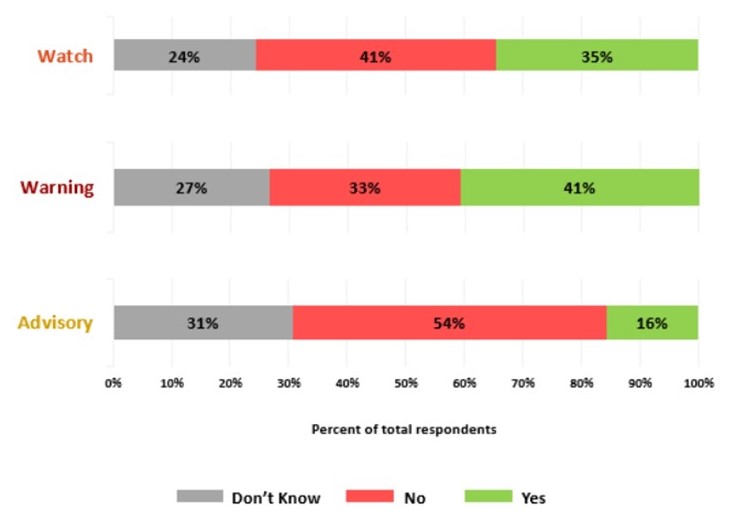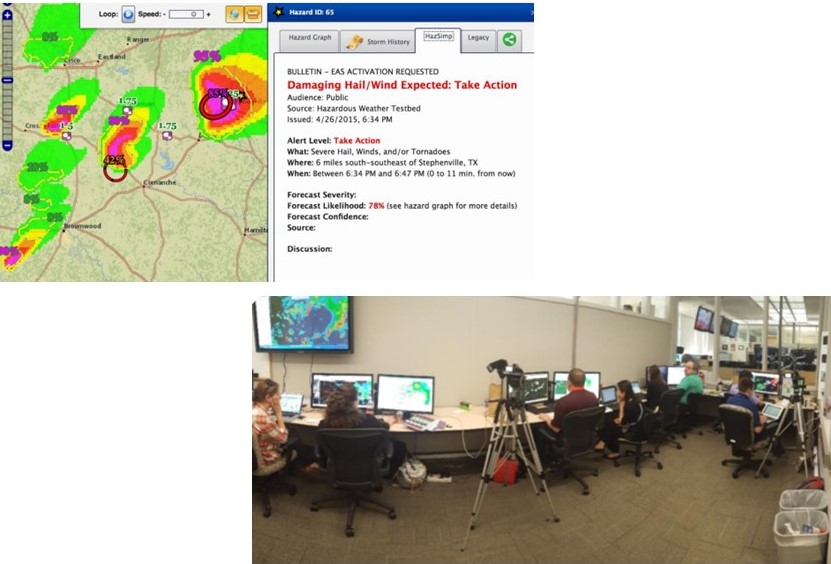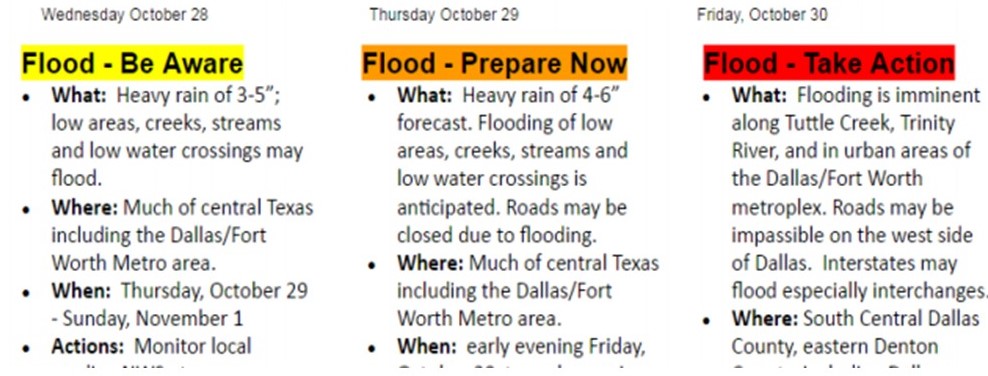
Initial efforts associated with this project date back to 2011, but the project formally “kicked-off” with full social science engagement in 2014. Below is a summary of data collection efforts NWS has supported to date. Click on the titles of each to view the associated reports from these efforts.
NWS sponsored a series of public surveys, each focusing on a different hazard. The surveys used representative samples so the results are generalizable to the broader population. The surveys tested public understanding of the current WWA terms and public response to four different prototypes as alternatives to the WWA system.
Watch and Warning were confused periodically. Advisory was least understood and often confused with Watch as well. In general, Warning was the most well understood term.
well understood term.
The term “Notice” performed well at the Watch level; in other words, people were more likely to monitor the situation and prepare when hearing a “Notice”.
Similarly, the terms “Orange Warning” and “Red Warning” performed well at the Advisory and Warning levels.
At the Emergency level, the term “Emergency” performed best at promoting the strongest action.
NWS sponsored a survey of organizations from 32 different sectors to determine the degree to which the WWA system was embedded or “institutionalized” in their decision-making, laws, policies, operating procedures, bylaws, or other activities or processes.

“Warning” was most embedded and “Advisory” the least
The WWA system was more embedded in policy than statute
Most respondents could adjust to a WWA system change within a year
Prototypes developed during the 2015 Haz Simp Workshop were tested with emergency managers, NWS forecasters, and broadcast media using the Hazardous Weather Testbed (HWT). This research approach put forecasters and partners in a simulated real-world environment.

Action-based language (e.g. Be Aware, Take Action) did not perform well within the Testbed. Forecasters especially had difficulty ‘issuing’ this type of message and tended to always choose “Take Action”.
The term “Warning” was deeply ingrained for all participants.
Participant agreement that any major changes to the system should continue to be tested via the Testbed in order to understand operability.
NWS sponsored a survey of over 700 emergency managers, broadcast media, and other weather, water, and climate enterprise partners. Participants were provided a weather event and asked to describe what went wrong and right from a hazard messaging perspective.
Simplify and consolidate products, including improved formatting and easy-to understand language
Increase NWS coordination and collaboration between Weather Forecast Offices (WFO)
Revisit WWA product definitions and criteria and consider a more impact-based focus
Expand education and outreach efforts regardless of the extent of change that occurs
The NWS hosted a 3-day Workshop with emergency managers, broadcast meteorologists, private sector partners, and social scientists to 1) develop a set of prototypes that could be tested to replace some or all of the WWA system and to 2) suggest ideas for WWA enhancements that could clarify/simplify NWS hazard messages.
There was a spectrum of change desired, from enhancing the current system by changing the “Advisory” term to blowing the system up  entirely by using new terminology and language.
entirely by using new terminology and language.
Of those that called for a new system, suggestions included a tiered approach using colors (e.g. yellow, red) or words (e.g. minor, severe) and action based language (e.g. prepare, act).
There was general support for consolidating and/or eliminating some products and improving product formatting, with bullets, colors, and who, what, where, and when details.
NWS sponsored 20 focus groups with emergency managers, broadcast media, NWS forecasters, and the public to assess strengths and weaknesses of the current “Watch, Warning, Advisory” (WWA) system and explore possible improvements to it.
There was a spectrum of understanding of the current WWA system, with “Advisory”  being least understood term.
being least understood term.
General support for a hierarchical system to replace or enhance the current system, using colors, symbols, or language (Example of ideas in adjacent image).
General agreement that there are too many WWA products (e.g. Flood Watch, Winter Storm Warning) and the product text can be confusing.
Many participants expressed caution toward any major change without proper research and testing. They also stressed the importance of a large public outreach campaign.